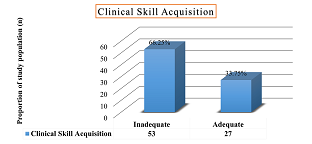Factors Affecting Skill Acquisition during Clinical Learning Among Preservice Registered Nursing Students at Levy Mwanawasa Medical University in Lusaka, Zambia

Abstract:
Clinical
learning is integral to nursing education, essential for the competence
development required in a three-year diploma program. This research aimed to
investigate factors affecting skill acquisition during clinical learning among
preservice Registered Nursing students at Levy Mwanawasa Medical University in
Lusaka, Zambia. A cross-sectional descriptive design, employing a
self-administered adapted questionnaire pretested for reliability in the UK and
Swaziland (Cronbach’s alpha: 0.77–0.96, correlation: 0.74) was used. Stratified
random sampling based on training level selected 80 participants meeting
inclusion criteria through a random sampling method. Data analysis included descriptive
statistics, chi-square tests, and binary logistic regression using SPSS version
26, with a 95% confidence interval and 5% significance level. The study
identified four predictors significantly correlated with skill acquisition
during clinical learning: inadequate supportive learning environment (100%,
n=80, p=0.003), inadequate Student-Patients allocation (83.75%, p=0.048), and
inadequate Resources (56.25%, p=0.002), and inadequate motivation to learn
(51.25%, p=0.037). Incompetence of clinical instructors and mentors (57.5%,
p=0.233) and mild Anxiety (85%, p=0.762). Binary
Logistic Regression, adjusted for independent variables, indicated that an
improved supportive learning environment decreased skill acquisition odds (Odds
Ratio=0.049, p=0.025), while increased resource availability raised odds (Odds
Ratio=3.338, p=0.01) for students who perceived these variables as inadequate.
The omnibus test was significant (chi-square=14.095, p=0.015), accurately
classifying 72.5% of cases. Collaboration among educators, clinical staff, and
policymakers is crucial for enhancing nursing education quality by addressing
factors affecting clinical skills acquisition.
Keywords: Anxiety, clinical learning, competence of clinical instructors and mentors, resources, skill acquisition, supportive learning environment.
References:
[1]. Ngaiyaye
P and Ellemes E (2017) Challenges in
Neonatal Nursing clinical teaching to Nurses. Journal of Nursing Education;
2015-2221.
[2]. Polit,
D F and Beck C T (2021) Nursing research generating and assessing evidence for
nursing practice. 11th ed.
Philadelphia, Pa.: Wolters Kluwer.
[3]. Drateru
K C (2019) Challenges Experienced by
Student Nurses during Skill Acquisition at the Clinical Area. Nursing Primary Care. Texila American
University, Uganda. 0614, NLM ID: 101570965 Science domain international.
[4]. Katowa-Mukwato
P and Banda S S (2017) Acquisition of
Competence in Clinical Practical Procedures: A Model of the University of
Zambia Medical School, British Journal of Medicine and Medical Research
19(8): 1-14, 2017; Article no. BJMMR.31279 ISSN: 2231-
[5]. Kaphagawani
N C and Useh U (2018) Clinical Supervision and support: Exploring Pre registration Nursing
Students‘ Clinical Practice in Malawi Annals of Global Health, DOI:10.29024/aogh.16.
[6]. Carson
M N, Lee JW, & Clarke C (2018) Nursing
students' learning dynamics and influencing factors in clinical contexts, Nurse Education in Practice, vol. 29,
pp. 103-109.DOI: 10.1016/j.nepr.2017.12.003.
[7].
Kaliyangile
B and
Ngoma CM (2020) Factors Influencing Student Nurses’ Clinical Learning during their
Clinical Practice at Rusangu University, Monze campus, Zambia. Texila
International Journal of Nursing. ISSN: 2520-3126 DOI:
10.21522/TIJNR.2015.06.01.Art003.
[8]. Bvumbwe
T and Mtshali N (2018) Nursing
education challenges and solutions in Sub Saharan Africa: an integrative review.
BMC Nurs. Jan 31; 17:3. Doi:
10.1186/s12912-018-0272-4. PMID: 29434521; PMCID: PMC5793415.
[9]. WHO (2020) State Of The Worlds Nursing 2020, Investing in education, jobs and
leadership ISBN 978-92-4-000327-9
(electronic version) ISBN 978-92-4-000328-6 (print version).
[10]. Kesmodel
U S (2018) Cross-sectional studies –
what are they good for?,
Department of Obstetrics and Gynecology, Herlev University Hospital, Herlev,
and Department of Clinical Medicine,
University of Copenhagen, Copenhagen, Denmark.
[11]. Krejcie
R V, and Morgan D W (1970) Determining
Sample Size for Research Activities. Educational and Psychological Measurement. Published
formula for determining sample size. The relationship between sample size and
total population illustrated. Accessed from http://home.kku.ac.th/sompong/guest accessed 05.02.2022.
[12]. Saarikoski
M and Strandell-Laine C (2018) The CLES-Scale: An Evaluation Tool for
Healthcare Education. Doi: 10.1007/978-3-319-63649-8.
[13]. Dhlamini
C (2011) Perceptions of students and
Nurse Educators on the integration of theory and practice in nursing education
in Swaziland: An exploratory – Descriptive study.
University of KwaZulu-Natal, Durban.
[14]. Bhandari
P (2020) Introduction to quantitative
Research. www.scribbr.com,
accessed 10.01.2022.
[15]. Central
Statitstics Office, (2019) Zambia in Figures, Lusaka Zambia.
[16]. Chambers M., Gallagher,
A., Borschmann, R., Gillard S., Turner K. and Kantaris X. (2014) The experiences of detained mental health service
users: Issues of dignity in care.
BMC Medical Ethics, 15, 50. https://doi.org/10.1186/1472-6939-15-50.
[17]. Akhu-
Zaheya L M, Shaban I A and Khater W A (2015) Nursing student’s perceived stress and influences in clinical
performance, International Journal of Advanced Nursing studies,
4(2); 44 _ 48. Doi.10. 14419/ijans.V4:2.4311.
[18]. Kamphinda S and Chilemba
E B (2019) Clinical supervision and support: Perspectives of
undergraduate nursing students on their clinical learning environment in
Malawi. Vol 42, No 1 | a1812, DOI: https://doi.org/10.4102/curationis.v42i1.1812.
[19]. Zamanzadeh
V, Valizadeh L, Rahmani A, van der Cingel M, Ghafourifard M (2018) Factors
facilitating nurses to deliver compassionate care: a qualitative study. Scand J Caring Sci. Mar;32(1):92-97.
doi: 10.1111/scs.12434. Epub 2017 Feb 3. PMID: 28156018.

